Contents
- 1 How Ik-Joong Kang Explores Human Connection Through Art
- 1.1 Interior Design: As a multimedia artist, what does creating a monumental public mural mean to you?
- 1.2 ID: There is a relationship between human connection and public art in the sense that art in public invites strangers to stop and enjoy a moment together. How do you see the role of public art in terms of creating connection?
- 1.3 ID: The mural is also visible from the street. How do you see the work’s integration into the urban landscape?
- 1.4 ID: 1392 Moon Jars (Wind) installation is about the order of multitudes, and so is Hangeul Wall. Could you talk about the importance of repetition in your work?
- 1.5 ID: Throw Everything Together and Add is about your own experience of New York while Hangeul Wall encapsulates innumerable stories by many. What fascinates you about monumentalizing the human experience?
- 1.6 ID: The mural offers visitors a different experience on each floor. What fascinates you about this particular aspect of a mammoth mural?
- 1.7 ID: Hangeul Wall has a plethora of colors and letters. What was your process of creating the color configuration?
- 1.8 ID: The screen also enables the work to constantly evolve. What is the importance of audience participation in your practice, especially in a mural that is inherently static?
- 1.9 ID: After exhibiting your work at museums and galleries for decades, what does a mural at a cultural center with heavy traffic mean in terms of connecting with a broader audience?
- 1.10 ID: Letters in any alphabet can also be seen as abstract forms. What fascinates you about the shapes of letters, particularly Hangeul?
Closeup of the Hangeul letters in the installation. Photography by Taehyun Hwang.
When Korean artist Ik-Joong Kang visited the then-nearly completed Korean Cultural Center New York (KCCNY) last May, he was surprised to see a massive wall with a design plan. “It was at least seven stories high, left as an architectural feature,” he says. The celebrated artist, known for mixed media sculptural installations that embody a form of togetherness, proposed the idea of creating a wall that reflects the Korean alphabet Hangeul to the center’s newly appointed director, Cheon-soo Kim. “I wanted the work to seamlessly integrate with the building’s design, making it look like a natural part of the structure,” adds Kang.
The process, which involved working with architects and construction experts, recently reached a finale and Hangeul Wall is open to the public at the cultural center in Manhattan’s bustling Koreatown. Stretching 70 feet tall, the permanent mural reaches the building’s fifth floor and is composed of 20,000 colorful tiles, each featuring a letter from the Korean alphabet, Hangeul. The artist is fascinated by how “Hangeul transcends being merely an alphabet and embodies a philosophy of yin and yang.”
He is particularly excited about the viewers ascend upwards while the perspective and the vantage points shift. “Personally, I enjoy the view of the mural from the viewpoint on the third floor, where the library is located,” adds Kang. The center’s visitors also will find a mini retrospective of the artist’s four-decade career with works loaned from the Guggenheim and the Whitney Museum of American Art. 1392 Moon Jars (Wind) (2008–10), for example, features 1392 glazed porcelain jars in a solar layout, while Throw Everything Together and Add (1984-96) is a horizontal display of around six thousand tiny mixed media paintings about the artist’s early years in New York.
Here, Kang talks with Interior Design about how public artwork facilitates connection, the joy of creating large-scale murals, and the sense of mystery inherent in alphabets across the world.
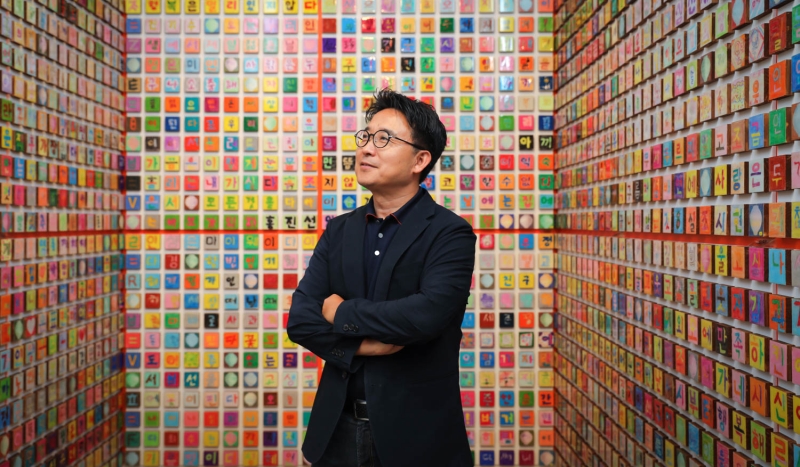
Portrait of Ik-Joong Kang. Photography by Kunning Huang.
How Ik-Joong Kang Explores Human Connection Through Art
Interior Design: As a multimedia artist, what does creating a monumental public mural mean to you?
Ik-Joong Kang: I view it as a revolutionary act that relies on three essential elements: the agenda—the purpose behind the work; the participants—those involved in the project; and the initiator—the person who starts it all.
As an artist, I must take into account all three elements from the outset, along with an added challenge which is the process itself. Determining the “how”—from executing the project to securing funding, maintaining the work, and engaging with the community—can be daunting. After more than 20 years in public art, I’ve come to believe that the focus should be on sharing, communicating, and exploring our place on the map. This journey is the essence of creating public art.
ID: There is a relationship between human connection and public art in the sense that art in public invites strangers to stop and enjoy a moment together. How do you see the role of public art in terms of creating connection?
IJK: As you mentioned the word “connection,” I believe the role of public art is deeply rooted in this concept. There are many ways for us to connect with one another. Just as a bridge facilitates traffic in one direction or both, public art serves as a medium for communication. In this context, I, as the artist, try to engage with the audience and participants, creating a shared experience that helps us understand our connection.
ID: The mural is also visible from the street. How do you see the work’s integration into the urban landscape?
IJK: I’ve always seen New York as a stained glass window rather than a melting pot. The melting pot concept erases the individuality and richness of diverse cultures, reducing them to a uniform blend. In contrast, a stained glass window showcases unique colors and shades, connecting without dividing. KCCNY is situated at the edge of Koreatown, bordering Murray Hill and Kips Bay. I hope that Hangeul Wall, which is visible from the street, serves as a border that connects and embraces, linking us to other parts of Manhattan and shining beautifully as sunlight filters through.
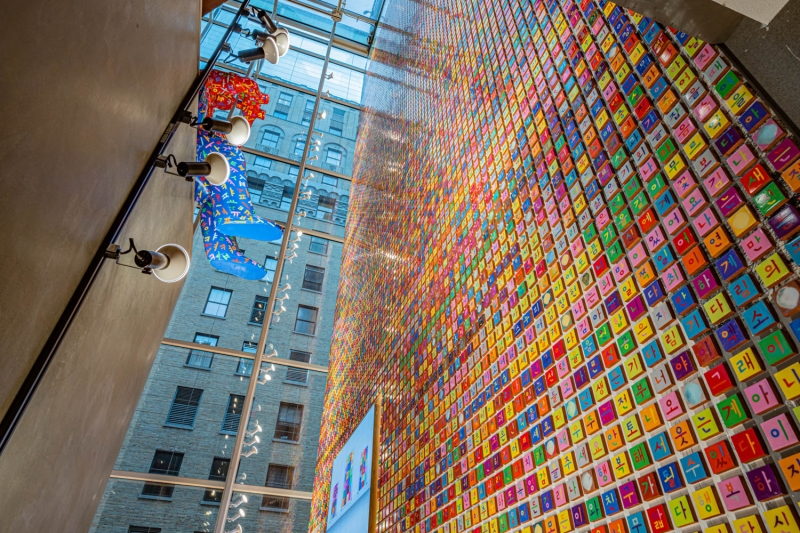
View of Hangeul Wall. Photography by Taehyun Hwang.
ID: 1392 Moon Jars (Wind) installation is about the order of multitudes, and so is Hangeul Wall. Could you talk about the importance of repetition in your work?
IJK: My habit of repetition began less than a year after I arrived in New York. I was working at a Korean deli while attending graduate classes at Pratt Institute during the day. Due to limited time, I turned to public transportation as my creative space. I created a small 3 x 3 inch canvas that I could carry in my pocket which allowed me to paint, draw, and even sew while in transit or walking. I dreamed of transferring these images to larger canvases when I could afford it. I often explained that the 3-inch size was inspired by the distance between my eyes, and I typically worked with the canvas in my palm. Over the past 40 years, I have created more than 100,000 paintings. This repetitive habit has become a diary of my life and a record of the passage of time for others as well.
ID: Throw Everything Together and Add is about your own experience of New York while Hangeul Wall encapsulates innumerable stories by many. What fascinates you about monumentalizing the human experience?
IJK: Collecting people’s stories and documenting them in one place is a fascinating way to communicate with the world and with our generation. It creates a collection of thoughts, much like a library, preserving artifacts for future generations to explore. These stories reflect the essence of New York and beyond—some come from the mountains, others from the ocean, and many from the corners of the city. They are shared by both young and old, encompassing joyful moments and challenging experiences. It’s like making bibimbap: throw everything together and add gochujang, the Korean hot pepper paste.
ID: The mural offers visitors a different experience on each floor. What fascinates you about this particular aspect of a mammoth mural?
IJK: One of Nam June Paik’s artworks currently on display at the National Museum of Modern and Contemporary Art in Korea is titled The More, The Better. It is made of 1,003 TV monitors arranged in the shape of a pagoda. In 2009, I installed over 60,000 small paintings and objects around Mr. Paik’s piece to create an experience reminiscent of climbing a mountain as one walks up the 200-meter-long circular ramp.
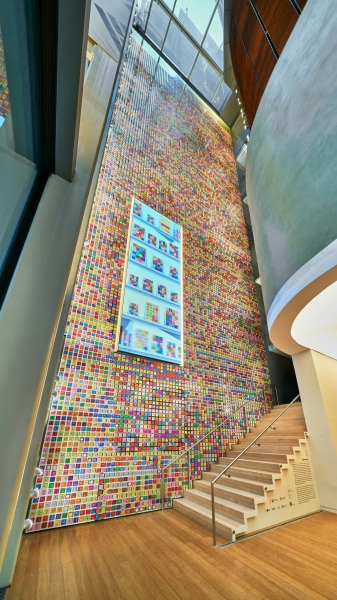
Hangeul Wall. Photography by Kunning Huang.
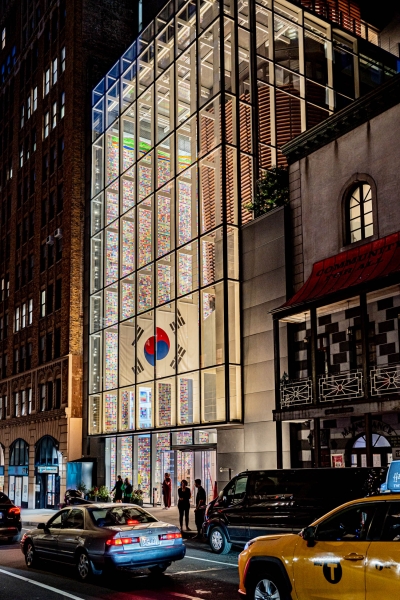
Hangeul Wall in the evening. Photography by Taehyun Hwang.
ID: Hangeul Wall has a plethora of colors and letters. What was your process of creating the color configuration?
IJK: The color configuration for Hangeul Wall actually has nothing to do with me; rather it was up to each participant who submitted a meaningful message on the KCCNY website to pick and coordinate at their creative liberty.
At the kiosk in front of Hangeul Wall, you have two options for crafting a personalized sentence. The first is to simply press the screen for automatic configuration. The second option allows you to choose each letter with your preferred colors, backgrounds, and unique vowel and consonant hues. I recommend the second method, as it offers more individuality and creativity, enabling you to create a truly unique piece of art. After completing the process, you can download it and email it to anyone. It’s a perfect tool for sending surprise messages to your loved ones.
ID: The screen also enables the work to constantly evolve. What is the importance of audience participation in your practice, especially in a mural that is inherently static?
IJK: To overcome the static nature of traditional murals, we developed an innovative method to bring Hangeul Wall to life. We collaborated with LG Electronics for a two-way communication platform that lets participants to connect and engage globally without time constraints. Since launching www.hangeulwall.org, we have had over 8.2 million visitors, with more than 7,000 individuals contributing their artwork within two months.
ID: After exhibiting your work at museums and galleries for decades, what does a mural at a cultural center with heavy traffic mean in terms of connecting with a broader audience?
IJK: As an artist, I feel that I have limitless freedom when creating large scale murals for public spaces because these pieces not only speak for our current generation, but also for future generations. To have a permanent installation at the KCCNY is an incredible honor and an immense responsibility because it must look towards the minds and sensibilities of our children’s children and so on.
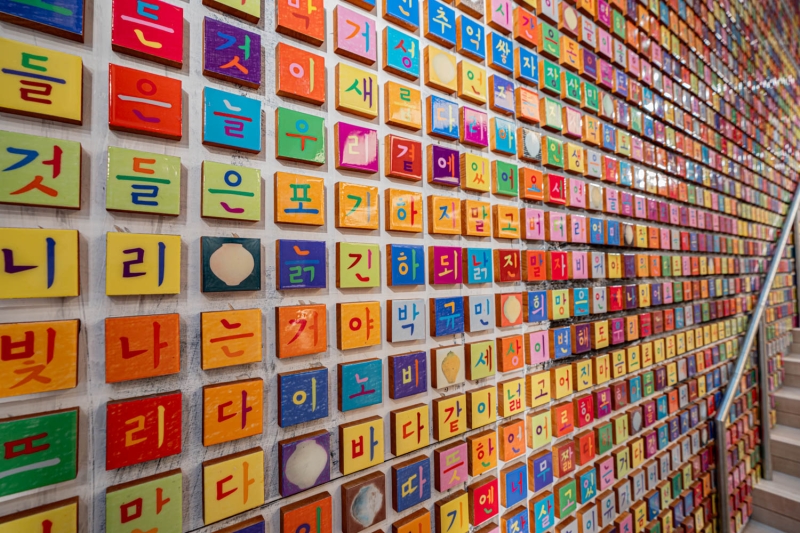
Closeup of the Hangeul letters in the installation. Photography by Taehyun Hwang.
ID: Letters in any alphabet can also be seen as abstract forms. What fascinates you about the shapes of letters, particularly Hangeul?
IJK: I recently installed a large outdoor public artwork titled Four Temples in front of the Pyramids of Giza in Egypt. This piece features four structures, each representing a different language: Korean, English, Arabic, and hieroglyphics, with the text translating the traditional Korean folk song “Arirang.” Arabic and hieroglyphics seem abstract to me due to my unfamiliarity, even though I colored each word with the help of translators. I imagine Hangeul might appear similarly abstract to those unfamiliar with it.
